News
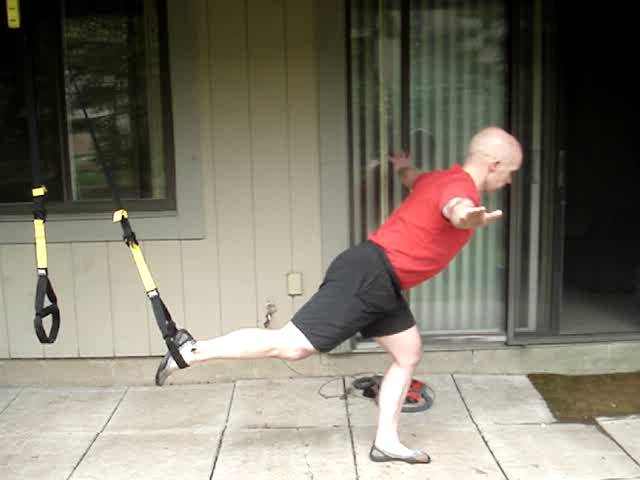
TRX Squat Variation Exercises
Here TRX Director of Programing and Education Fraser Quelch shows you a few excellent variations to the TRX Squat for an intense lower body and core workout.
A squat can be defined as any movement where one flexes through the hips, knees and ankle. While the squat appears to occur primarily in the sagittal plane of movement, the movement available at the spine, hips, knees and feet/ankle usually involves all three planes (sagittal, frontal and transverse) of movement. Want to find the perfect squat variations for your fitness level? Take our quick assessment quiz to get a personalized training plan that focuses on proper form and progression. The TRX can be used to tweak the squat movement pattern so that we can focus on all three planes of movement and promote more functional, proprioceptively enhanced joint and muscular function at the foot/ankle, knee, hip and spine, improving one's ability to move and function. Below are some squat variations using the TRX.
TAKE OUR TRAINING QUIZ
TRX Single Leg Squat to Crossing balance Lunge
This exercise combo below provides a challenging variation on the standard squat. Whether you use it as a warm up or part of your routine, this combo can inspire endless possibilities.
TRX Overhead Back Extension to TRX Overhead Squat
This video below takes two powerful movements, the TRX Overhead Back Extension and the TRX Overhead Squat, and combines them for one intense move that creates thoracic extension and improves postural strength.
This cool combo below, featuring the TRX Single Leg Squat and the TRX Crossing Balance Lunge, can be done slowly or powered through quickly, depending on your comfort level and focus. Pay special attention to form and function to maximize the benefit of combining these two great TRX exercises.
The number of foot positions is endless when it comes to squatting. You can adopt a side by side or staggered stance for the sagittal plane variations, wide stance or feet close together for frontal plane variations and internally rotated or externally rotated feet for the transverse plane variations. While these are some of the more common ways of altering foot position during the squat, the ability to combine some of these positions means there are actually multiple ways to modify a squat.
The same can be said for the arm/hand positions during a squat. Altering your arm or hand position during the exercise can allow us to focus the squat on a particular plane of movement and perhaps specific area of the body. Typically, overhead arm/hand positions are more likely to reduce hip/pelvis movement and focus the squat more on foot/ankle and knee structures. Arm/hand positions at waist to ground level will focus the squat more on the hip/pelvis structures.
Designing Your Training Program
When squatting with the TRX, look to incorporate the squat variations in your workout as either movement-based warm ups or specifically within a planned workout to focus on improving overall general squatting ability. These exercises are just a sample of the different ways you can use the TRX to improve your squatting ability.
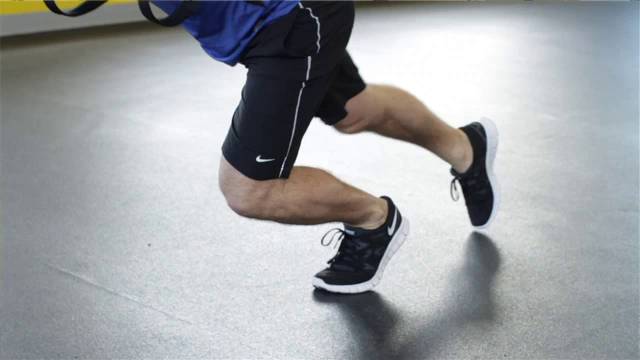
TRX Sprinter Start with Chris Frankel
To get the most out of your TRX Training you must master the basic movement before you earn your progression, add on intensity, and take an exercise to next level. Want to find the right progression path for your skill level? Take our quick assessment quiz to get a personalized training plan that builds from the fundamentals. In this video, TRX Director of Human Performance, Chris Frankel demonstrates this concept with the TRX Sprinter Start.
TAKE OUR TRAINING QUIZ
Start with a solid standing plank, lining up your knees, hips and shoulders brace your core and squeeze your glutes. This plank is the end range of motion for this exercise you will return to this plank at the end of every rep. Step back with one foot to get into the TRX Sprinter Start position and then bring this leg forward to meet the other foot and reset your plank. This is the standard, master it before you move on and nail that plank at the top on every rep.
Once you have the basic movement down you can progress this exercise by driving the knee of the working leg up to pause for a brief single leg plank at the top, or progress further and let the working leg drive into a small hop at the end range of motion.The goal is to maintain control and master your level of progression with perfect form before you layer intensity on top of it. This is how the concept of earning your progression applies to the TRX Sprinter Start.
Buy your TRX Suspension Trainer here.

TRX Sprinter Start Exercise
This TRX exercise targets the muscular endurance and power of the quadriceps, hamstrings and gluteals, shown here with Fraser Quelch and TRX founder and CEO Randy Hetrick. It's also an excellent way to get your heart rate elevated in no time.
Fraser Quelch is Director of Training and Development for TRX. He is also a featured fitness author and a competitive Ironman triathlete.
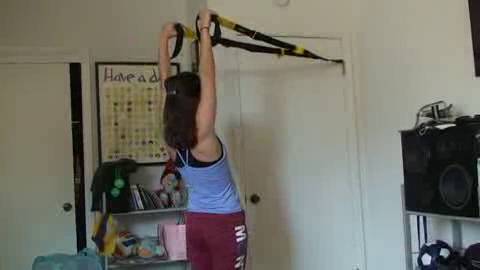
TRX Small Space Workout
Here is a workout you can do, no matter the size of your living space. Recent college grad and TRX marketing intern Jamie Adam (and a friend) demonstrates a TRX workout designed specifically for tight quarters, so now you have no excuse to skip a workout. Do one set of each of the following exercises two to three times a week... or whenever you can find time during study breaks.
Exercise
Reps
TRX Chest Press
10-15 reps
TRX Triceps Press
10-15 reps
TRX Biceps Curl
10-15 reps
TRX High Row
10-15 reps
TRX Single Leg Squat
10-15 reps (each leg)
TRX Y Deltoid Fly
8-10 reps
TRX W Deltoid Fly
8-10 reps
TRX Lunge
10-15 reps (each leg)
TRX Crunch
10-15 reps
TRX Hip Press
10-15 reps
NOTE: Enrollment in higher education institution optional. TRX Dorm Room Workout can be performed in any tight space, anywhere.
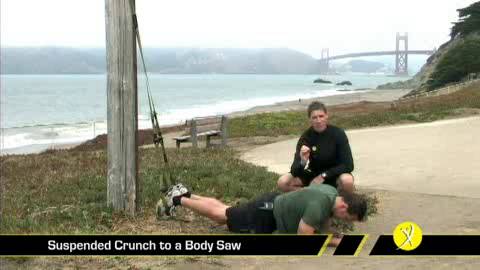
TRX Ski Conditioning Workout: Part 1
As storms lay blankets of powder on ski resorts across the northern hemisphere, say adios to autumn and get ready to hit the slopes. But before you drift into daydreams of wowing the folks on the lift with your supreme mogul technique or your jibbing skills in the terrain park, take a moment to think about what kind of season you want to have. Want to find the perfect pre-season training plan for your winter sports goals? Take our quick assessment quiz to get a customized workout program that'll get you slope-ready. Do you want to be in dynamite condition, ready for another charge down the hill? Do you want to make it through the season with your knees intact? Then you've come to the right place. Whether you snowboard or ski, rock at a green or double diamond level, training on the TRX can help you reach your best this season. The goals of your winter sports TRX training will be two-fold:
TAKE OUR TRAINING QUIZ
Train your body into the best condition possible for the specific demands of your sport.
Prevent injuries before they happen by preparing your body for the inevitable impacts that come with sliding on snow.
Below is Part 1 of our two part TRX program for skiing and snowboarding that will have you shred-ready in 9-12 weeks.
In weeks 1-3, focus on form and increasing mobility.
In weeks 4-6, add speed, increase tempo of exercises.
In weeks 7-9, emphasize power with explosive movements and increased resistance.
Start with 30 seconds per exercise/side each three-week cycle.
When 30 seconds per exercise becomes manageable, add 15 seconds.
Progress with15 more seconds per exercise as needed.
Complete the following set of exercises as many times as you can in 20 minutes. Start with two days a week and build up to as many as four days per week over the course of nine weeks.
TRX Ski Conditioning Workout - Part 1
Exercise #1: TRX Body Saw (with Crunch) (see above video)
Exercise #2: TRX Pike
Exercise #3: TRX Side Plank (with Taps)
Exercise #4: TRX Overhead Back Extension
Get out there, do Part 1 of the workout and let us know what you think in the Forums. And stay tuned for TRX Ski Conditioning - Part 2.
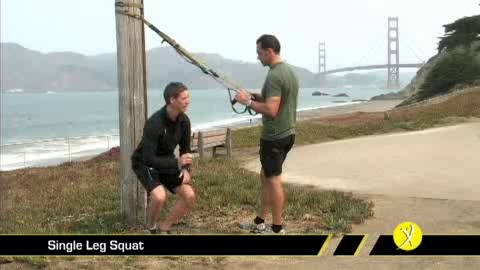
TRX Single-Leg Squat
This movement is the essence of functional, lower-body strength demanding strength, power, stability and balance. Want to find the right progression for your fitness level? Take our quick assessment quiz to get a personalized training plan. Shown here with Fraser Quelch and TRX founder and CEO Randy Hetrick.
TAKE OUR TRAINING QUIZ
Fraser Quelch is Director of Training and Development for TRX. He is also a featured fitness author and a competitive ironman triathlete.
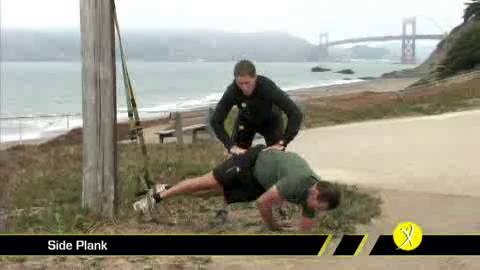
TRX Side Plank
The TRX Side Plank is an incredibly effective and demanding exercise that requires complete core coordination and tremendous strength from the quadratus lumborum and obliques. Want to find the right plank progression for your core strength? Take our quick assessment quiz to get a personalized training plan. You can regress the TRX Side Plank so that it can be used for de-conditioned clients.
TAKE OUR TRAINING QUIZ
Adding hip abduction to the standard TRX Side Plank is a very demanding action that builds hip stability and glute strength and endurance.
Fraser Quelch is Director of Training and Development for TRX. He is also a featured fitness author and a competitive Ironman triathlete.
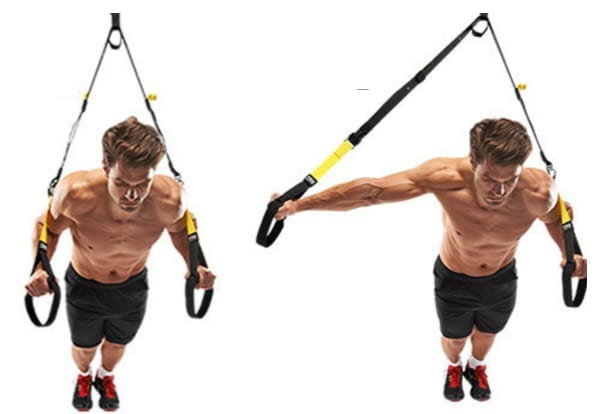
TRX Shoulder Stability Workout
If your weekend plans include making a trip to your local ballpark to take in America's pastime, pause between bites of that frank to note the number of players on the DL. Want to train like the pros while avoiding common baseball injuries? Take our quick assessment quiz for a customized workout plan designed for ballplayers. Injuries among Major League Baseball players are on the rise, according to recent research published in the American Journal of Sports Medicine.
TAKE OUR TRAINING QUIZ
In the study, pitchers got hurt most often, accounting for 62 percent of all disability days; most of these injuries are to the serratus anterior muscle, an important muscle that:
Helps control shoulder and scapular function by protracting and upwardly rotating the scapula
Assists in stabilizing the scapula against the rib cage, preventing scapular winging
Helps prevent shoulder impingement
As Head Athletic Trainer of the Boston Red Sox and leading expert in the field of physical therapy, Mike Reinold has developed protocols to address injury to the serratus anterior.
While traditional protraction exercises have been effective in strengthening the serratus, Mike cites recent research that has identified that serratus activity is increased when combining both protraction and upward rotation of the scapula. “This movement helps to train the serratus in a functional pattern that combines the muscle’s important role in scapular mobility,” says Mike.
Based on this research, Mike began using a dynamic jab exercise as a baseline for basic training and rehabilitation of the serratus. Since this exercise is quickly mastered, further challenge is required. “Incorporating a closed kinetic chain position and unstable surface training will require a greater degree of dynamic stability of the scapula and promote neuromuscular control,” says Mike. To achieve this, he began incorporating the TRX Suspension Trainer into his rehabilitation programs and created the TRX Serratus Slide.
“The TRX Suspension Trainer is an excellent method of performing the serratus slide exercise that challenges both the strength and stabilizing functions of the serratus muscle,” says Mike. “Furthermore, the amount of challenge can quickly be adjusted by modifying the angle of the exercise.”
To begin, place your forearms onto the TRX handles or foot cradles (see video above).
Lean forward, keeping your elbows tucked by your sides.
Elevate your arms and round your scapula around your rib cage.
Push out and up until your elbows are close to eye level.
Pause at the top of the movement with your shoulders rounded and slowly return to the start position.
Keeping the serratus anterior muscle strong will not only give clients and athletes a defined chest but also will keep the shoulder joint stable and healthy. Great news if you’re a MLB pitcher… or planning to dominate on the mound at the next corporate softball game.
Mike Reinold is currently the Head of Athletic Training of the Boston Red Sox and a leading expert in the field of physical therapy, athletic training and strength and conditioning. He has published and lectured extensively regarding topics of rehabilitation and sports medicine and shares his thoughts and experience on his website (www.MikeReinold.com).
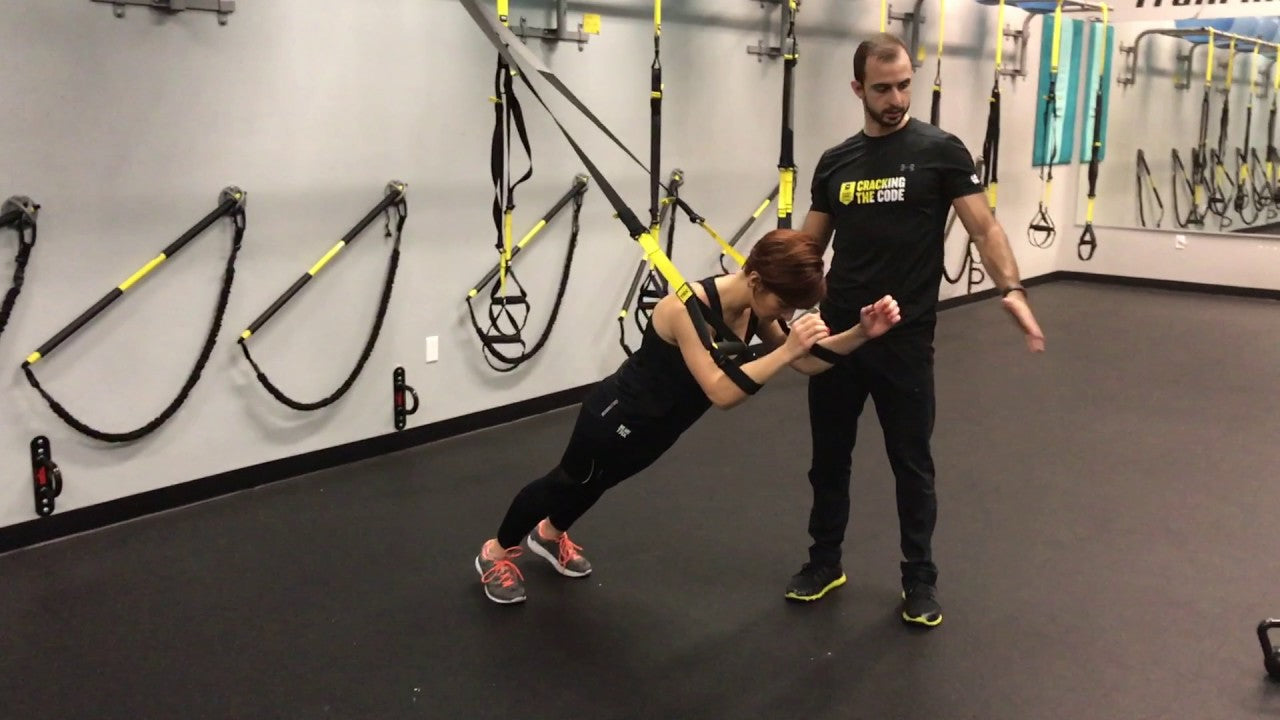
TRX Shoulder Stability Workout 2
Regaining shoulder stability and eventually strength at end ranges of shoulder motion can be difficult in the rehabilitation process. The TRX Suspension Trainer provides an easy way to progress patients/clients from a stable shoulder position to one requiring a large amount of stability and strength.
Here, Dr. Jennifer Reiner demonstrates her top exercises to regain end range shoulder stability using the Suspension Trainer. Not sure which shoulder exercises are right for your level? Take our quick assessment quiz to get personalized recommendations for your recovery journey. The exercises below begin in the supine position and advance to a kneeling and eventually standing posture while focusing on posture and shoulder integrity.
TAKE OUR TRAINING QUIZ
1. TRX Supine Reciprocal Shoulder Pattern
Begin with the Suspension Trainer fully lengthened and lying on your back with your head under the anchor point. For patients who are unable to achieve full shoulder flexion, simply shorten the strap to a range comfortable for the client. Place one arm above the head in shoulder flexion and the other by the hip in shoulder extension. The arm above should be palm up and the arm below, palm down. Keep the elbows straight and the head relaxed while depressing the shoulder blades. Apply pressure downward into the foot cradles with the backs of the hands.
2. TRX Supine Y Deltoid FlyBegin with the Suspension Trainer fully lengthened and lying on your back with your head under the anchor point. For patients who are unable to achieve full shoulder flexion, simply shorten the strap. Place both arms above head in shoulder flexion keeping the elbows straight. Palms should be facing the ceiling, the head relaxed on the ground, and scapulae depressed. Apply downward pressure into the foot cradles with the back of the hands.
3. TRX Kneeling Y Deltoid FlyBegin with the Suspension Trainer in the mid length position facing your anchor point. Place your arms into a Y position and assume a kneeling posture so that your body is upright with your arms overhead. Slowly lower your body backward maintaining a plank position from your knees to your shoulders. To return, drive your knuckles back keeping your chest up towards the anchor point and your shoulder blades depressed.
4. TRX Y Deltoid FlyPlace the Suspension Trainer in the mid length position and stand facing your anchor point. Set the arms into the Y position and then adopt an offset foot stance. Maintaining a plank position with the arms straight, slowly lower your body backwards. On the return, drive the knuckles back keeping the shoulder blades depressed and the chest up toward the anchor point.
Dr. Jennifer Reiner is the chiropractor for Water and Sports Physical Therapy providing sports rehabilitation services Todd Durkin’s facility, Fitness Quest 10. She is also a TRX Sports Medicine instructor. Dr. Jenn obtained a Bachelor's of Science Degree in Exercise Physiology from the University of Florida and went on to pursue a Doctor of Chiropractic degree from Palmer College of Chiropractic West. As a member of the Palmer West Sports Council, Dr. Reiner focused her studies on sports injuries and rehabilitation.
